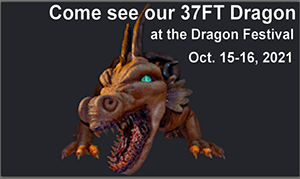Once the metal frame was done, Jennifer Buckingham was able to add the ‘meat’ with a spray foam insulation then carve her details in. The full Dragon was then ‘scaled’ using the actual fossil from the Lepidodendrin Tree to fit the lore described in ‘The Orgin of Dragons’ scientific paper done by DB Poli and Lisa Stoneman.
Life Size Dragon
Project
January 20, 2020 we assembled Tiamat at Olin Gallery at Roanoke College (see video). Olin Gallery is the first stop in a series of places she will travel to. Tiamat is our rendition of Tiamat from the Gate of Ishtar on the Babylonian wall, we chose this model because of how it fit in with the science behind the lore of the orgin of dragons. She is also the oldest known rendered dragon in existence.
Dragon Assembly
A short video of putting Tiamat together at the Olin Gallery
Tiamat is a 37 ft long dragon Made by The Color of Mud. As per usual our own Mike created the frame using the miniature J. Leigh (Jennifer Buckingham) sculpted. The small sculpture was 3D scanned and brought into an engineering program where Mike was able to build the metal frame virtually then eventually size it up and get exact dimensions and angles to weld it together.
“On the Origins of Dragons” makes an intriguing case tying the notion of the existence of dragons to the fossils of a certain kind of prehistoric tree.
The idea that legends of dragons could be inspired by fossils of a plant similar to a fern, known as Lepidodendron, or “scale tree.” More than 300 million years ago, these towering 100-foot-tall “scale trees,” covered with a bark-like surface that resembles reptile scales, grew all over the world’s land mass, a single continent called Pangaea. Their fossils, frequently found in coal seams, could resemble limbs, claws or even eyes of an immense reptilian creature.
The research group’s hypothesis suggests that the concept of dragons arose wherever early humans found these fossils.
Gretna artist Jennifer Buckingham created a life-size — or should that be larger-than-life size? — Dragon for the show that makes use of the bark patterns found on the fossils. The dragon, 37 feet long, is a rendition of Tiamat, an ancient Mesopotamian dragon goddess. The dragon’s skin was created using a stamping technique that employed the use of 3D scanned fossil scales and 3D printing.
Allen, Mike. “Imagining Dragons.” The Roanoke Times. Feb. 6, 2020
See the full article here: Arts & Extras: Imagining dragons

